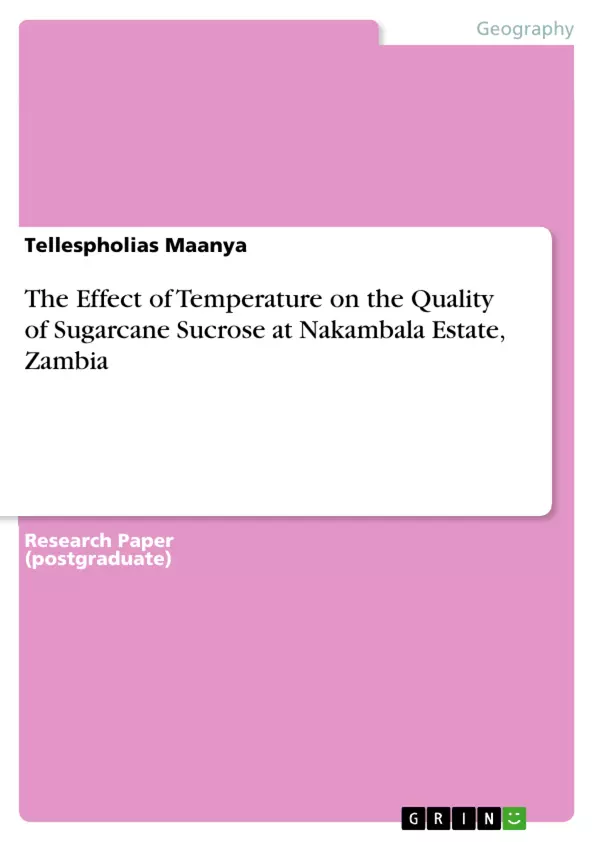Global, regional, and national temperatures have indeed been on an increase over the past few decades. This rise in temperature can have significant changes not only on the quantity but also on the quality of production in the agriculture sector. Hence, the study on the effect of temperature on the quality of sugarcane sucrose produced in the last twenty (20) years from the year 2001 to 2020 at Nakambala estate was instituted. Nakambala estate is located 125km south of Lusaka, Zambia at a geographical location of 15o 52′ 0′′ S and 27o 46′ 0′′ E.
This scientific study used historical data measured by an automated sacharimeter (to test for sucrose content) at the Direct Analysis of Cane Laboratory (DAC) stored on the Nakambala intranet communication systems. The temperature data was obtained from the automated meteorological station located at geographical coordinates 15o 14′ 85′′ S and 27o 44′ 31′′ E. The temperature analysed was the average of the maximum and minimum temperature.
The mean yearly temperature values were obtained from the annual monthly means and were plotted on graphs against time. The sucrose quality against time was plotted to establish relationships. The sugarcane sucrose quality data was detrended to remove other influencing factors on sucrose quality. Similarly, the non-detrended data was also used to obtain relationships with annual mean temperature. The excel data analysis tool pack was used obtain tables for the Analysis of Variance and the regression analysis.
Inhaltsverzeichnis (Table of Contents)
- CHAPTER 1.
- INTRODUCTION….………………………………………………….
- 1.1 Background of the study...
- 1.2 Statement of the problem
- 1.3 Research objectives ...
- 1.4 Research questions.
- 1.5 Hypothesis.........
- 1.6 Justification.......
- 1.7 Theoretical framework....
- CHAPTER 2..............
- 2 LITERATURE REVIEW.
- 2.1 Introduction
- 2.2 Temperature and sugarcane sucrose......
- 2.3 Sugarcane Flowering and Sucrose Quality..
- 2.4 Sucrose quality and sugarcane ripening..
- 2.5 Sugarcane planting..
Zielsetzung und Themenschwerpunkte (Objectives and Key Themes)
This dissertation investigates the influence of temperature on the quality of sugarcane sucrose produced at Nakambala Estate, Zambia, over a 20-year period. The study utilizes historical data collected from an automated saccharimeter and a meteorological station to analyze the relationship between temperature fluctuations and sucrose content. It aims to determine whether increasing temperatures have a significant impact on the quality of sugarcane sucrose.
- The impact of temperature on the quality of sugarcane sucrose.
- The relationship between temperature and sucrose content.
- The potential for climate change to influence sugarcane production.
- The analysis of historical data on temperature and sugarcane sucrose quality.
- The application of statistical techniques to determine significant relationships.
Zusammenfassung der Kapitel (Chapter Summaries)
- Chapter 1: This chapter provides an introduction to the study, outlining the background, statement of the problem, research objectives, research questions, hypothesis, justification, and theoretical framework. It sets the stage for the investigation of the impact of temperature on sugarcane sucrose quality.
- Chapter 2: This chapter presents a comprehensive review of relevant literature, exploring existing knowledge on the relationship between temperature, sugarcane flowering, sucrose quality, ripening, and planting practices. It provides a theoretical foundation for the study's findings.
Schlüsselwörter (Keywords)
This research focuses on the effect of temperature on sugarcane sucrose quality, using historical data from Nakambala Estate in Zambia. Key terms and concepts include sugarcane sucrose, temperature, climate change, quality, data analysis, statistical analysis, and agriculture.
- Quote paper
- Tellespholias Maanya (Author), 2022, The Effect of Temperature on the Quality of Sugarcane Sucrose at Nakambala Estate, Zambia, Munich, GRIN Verlag, https://www.grin.com/document/1263147



